FORD F750 2015 13.G Owners Manual
Manufacturer: FORD, Model Year: 2015, Model line: F750, Model: FORD F750 2015 13.GPages: 384, PDF Size: 4.95 MB
Page 151 of 384
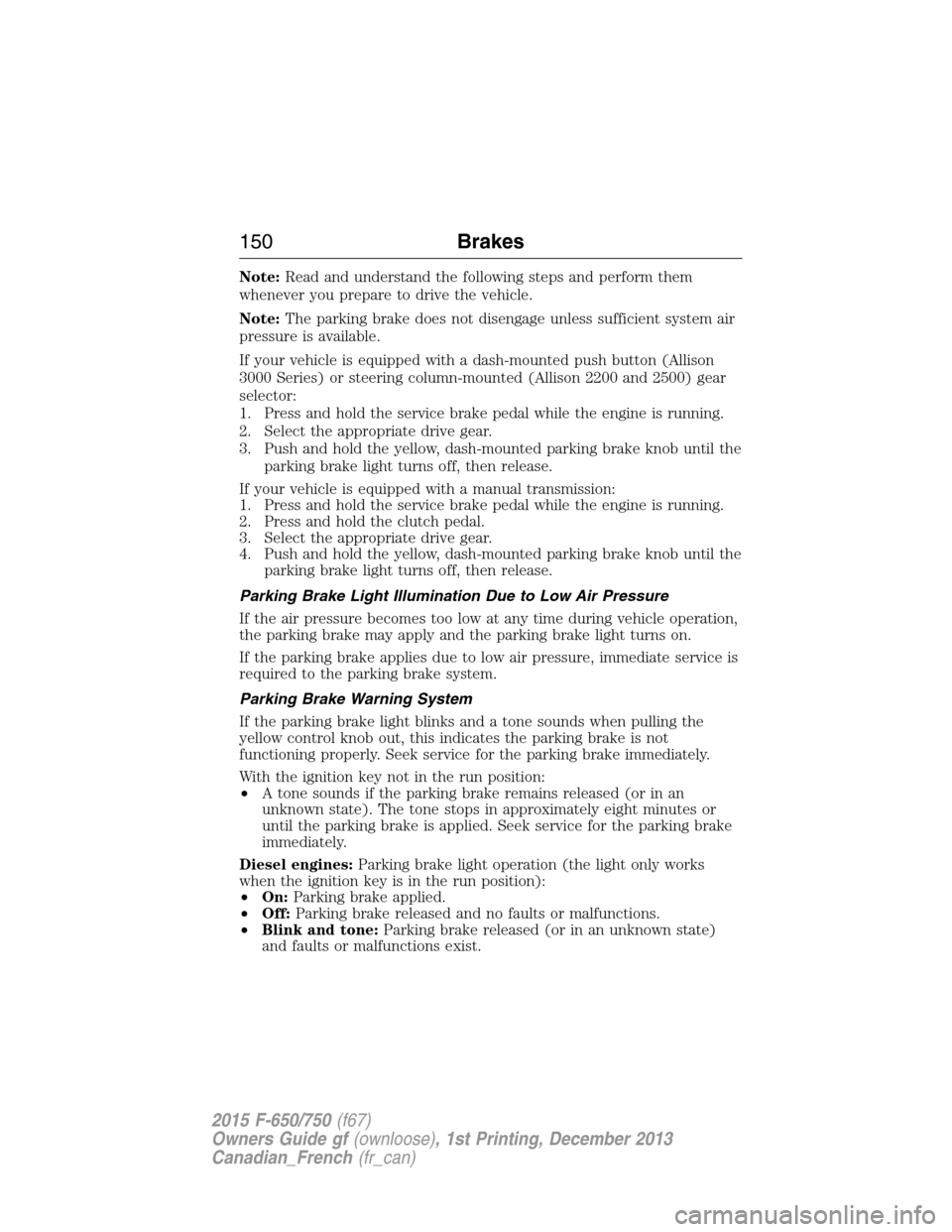
Note:Read and understand the following steps and perform them
whenever you prepare to drive the vehicle.
Note:The parking brake does not disengage unless sufficient system air
pressure is available.
If your vehicle is equipped with a dash-mounted push button (Allison
3000 Series) or steering column-mounted (Allison 2200 and 2500) gear
selector:
1. Press and hold the service brake pedal while the engine is running.
2. Select the appropriate drive gear.
3. Push and hold the yellow, dash-mounted parking brake knob until the
parking brake light turns off, then release.
If your vehicle is equipped with a manual transmission:
1. Press and hold the service brake pedal while the engine is running.
2. Press and hold the clutch pedal.
3. Select the appropriate drive gear.
4. Push and hold the yellow, dash-mounted parking brake knob until the
parking brake light turns off, then release.
Parking Brake Light Illumination Due to Low Air Pressure
If the air pressure becomes too low at any time during vehicle operation,
the parking brake may apply and the parking brake light turns on.
If the parking brake applies due to low air pressure, immediate service is
required to the parking brake system.
Parking Brake Warning System
If the parking brake light blinks and a tone sounds when pulling the
yellow control knob out, this indicates the parking brake is not
functioning properly. Seek service for the parking brake immediately.
With the ignition key not in the run position:
•A tone sounds if the parking brake remains released (or in an
unknown state). The tone stops in approximately eight minutes or
until the parking brake is applied. Seek service for the parking brake
immediately.
Diesel engines:Parking brake light operation (the light only works
when the ignition key is in the run position):
•On:Parking brake applied.
•Off:Parking brake released and no faults or malfunctions.
•Blink and tone:Parking brake released (or in an unknown state)
and faults or malfunctions exist.
150Brakes
2015 F-650/750(f67)
Owners Guide gf(ownloose), 1st Printing, December 2013
Canadian_French(fr_can)
Page 152 of 384
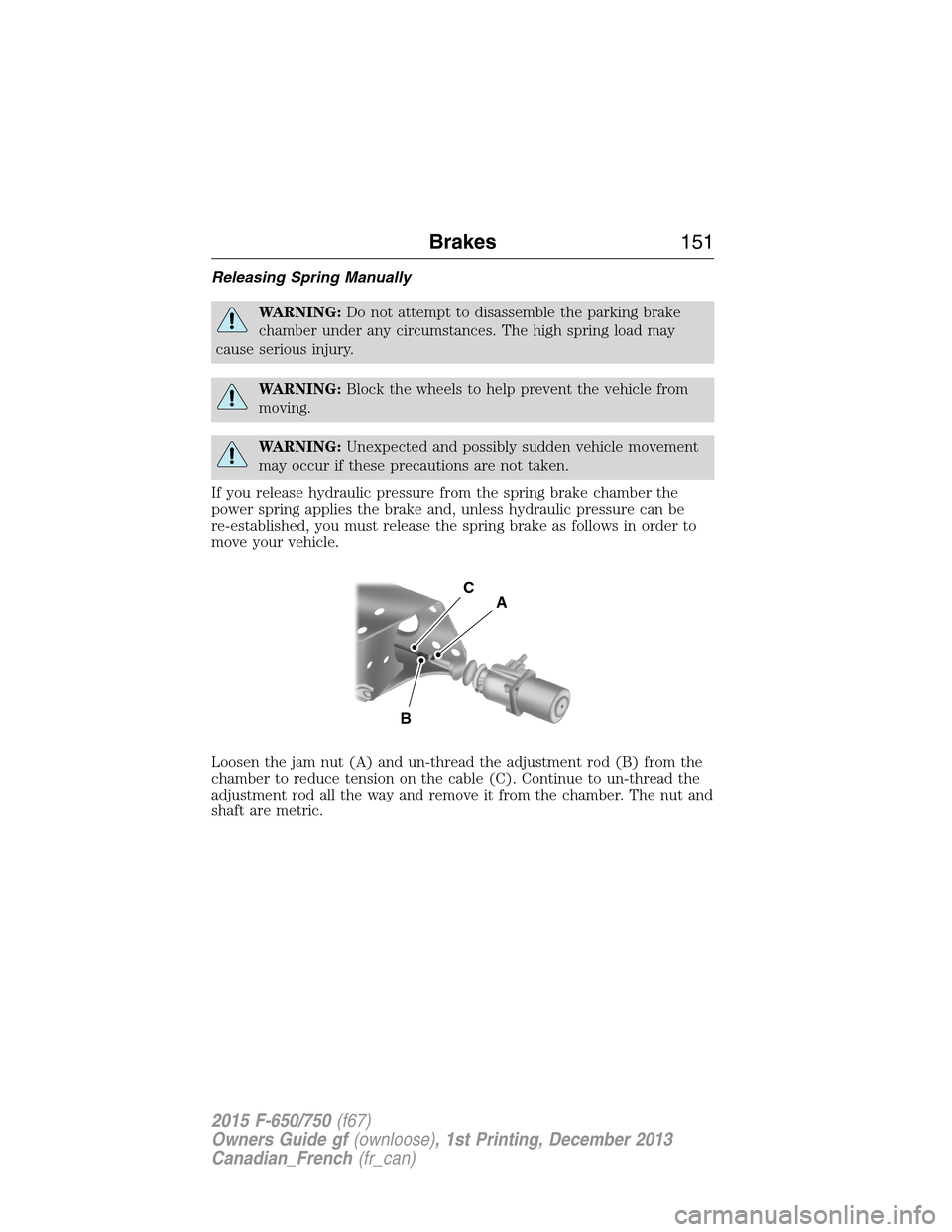
Releasing Spring Manually
WARNING:Do not attempt to disassemble the parking brake
chamber under any circumstances. The high spring load may
cause serious injury.
WARNING:Block the wheels to help prevent the vehicle from
moving.
WARNING:Unexpected and possibly sudden vehicle movement
may occur if these precautions are not taken.
If you release hydraulic pressure from the spring brake chamber the
power spring applies the brake and, unless hydraulic pressure can be
re-established, you must release the spring brake as follows in order to
move your vehicle.
Loosen the jam nut (A) and un-thread the adjustment rod (B) from the
chamber to reduce tension on the cable (C). Continue to un-thread the
adjustment rod all the way and remove it from the chamber. The nut and
shaft are metric.
CA
B
Brakes151
2015 F-650/750(f67)
Owners Guide gf(ownloose), 1st Printing, December 2013
Canadian_French(fr_can)
Page 153 of 384
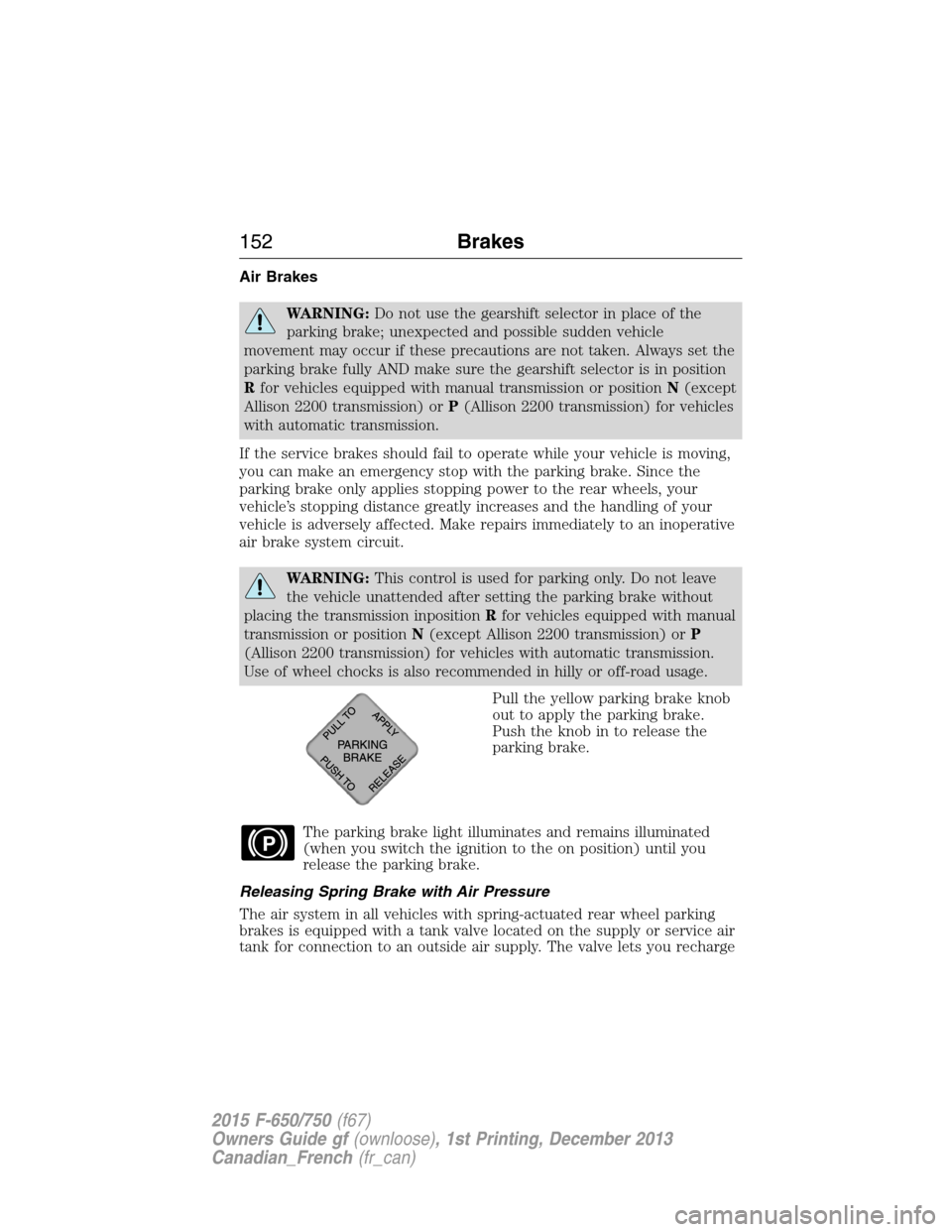
Air Brakes
WARNING:Do not use the gearshift selector in place of the
parking brake; unexpected and possible sudden vehicle
movement may occur if these precautions are not taken. Always set the
parking brake fully AND make sure the gearshift selector is in position
Rfor vehicles equipped with manual transmission or positionN(except
Allison 2200 transmission) orP(Allison 2200 transmission) for vehicles
with automatic transmission.
If the service brakes should fail to operate while your vehicle is moving,
you can make an emergency stop with the parking brake. Since the
parking brake only applies stopping power to the rear wheels, your
vehicle’s stopping distance greatly increases and the handling of your
vehicle is adversely affected. Make repairs immediately to an inoperative
air brake system circuit.
WARNING:This control is used for parking only. Do not leave
the vehicle unattended after setting the parking brake without
placing the transmission inpositionRfor vehicles equipped with manual
transmission or positionN(except Allison 2200 transmission) orP
(Allison 2200 transmission) for vehicles with automatic transmission.
Use of wheel chocks is also recommended in hilly or off-road usage.
Pull the yellow parking brake knob
out to apply the parking brake.
Push the knob in to release the
parking brake.
The parking brake light illuminates and remains illuminated
(when you switch the ignition to the on position) until you
release the parking brake.
Releasing Spring Brake with Air Pressure
The air system in all vehicles with spring-actuated rear wheel parking
brakes is equipped with a tank valve located on the supply or service air
tank for connection to an outside air supply. The valve lets you recharge
P
152Brakes
2015 F-650/750(f67)
Owners Guide gf(ownloose), 1st Printing, December 2013
Canadian_French(fr_can)
Page 154 of 384
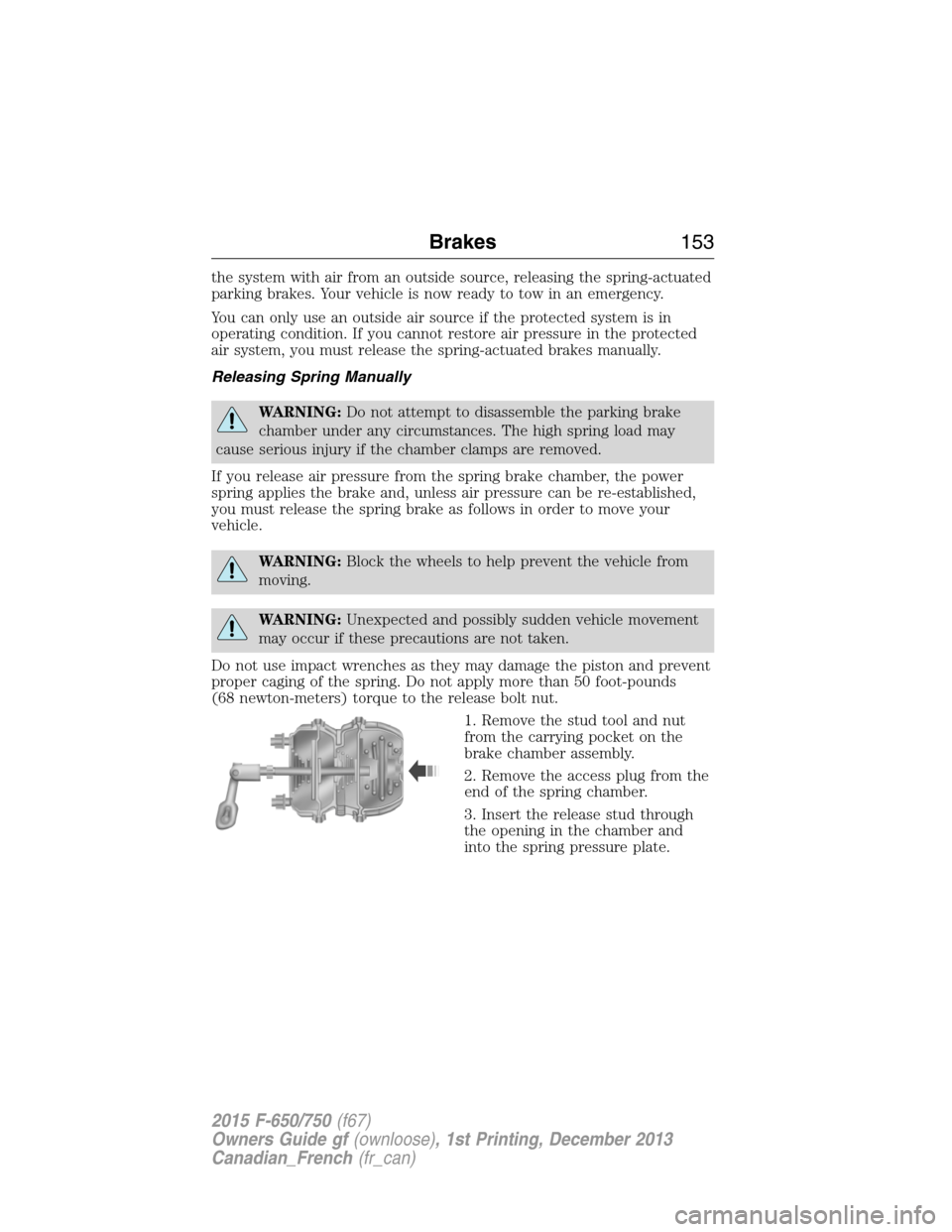
the system with air from an outside source, releasing the spring-actuated
parking brakes. Your vehicle is now ready to tow in an emergency.
You can only use an outside air source if the protected system is in
operating condition. If you cannot restore air pressure in the protected
air system, you must release the spring-actuated brakes manually.
Releasing Spring Manually
WARNING:Do not attempt to disassemble the parking brake
chamber under any circumstances. The high spring load may
cause serious injury if the chamber clamps are removed.
If you release air pressure from the spring brake chamber, the power
spring applies the brake and, unless air pressure can be re-established,
you must release the spring brake as follows in order to move your
vehicle.
WARNING:Block the wheels to help prevent the vehicle from
moving.
WARNING:Unexpected and possibly sudden vehicle movement
may occur if these precautions are not taken.
Do not use impact wrenches as they may damage the piston and prevent
proper caging of the spring. Do not apply more than 50 foot-pounds
(68 newton-meters) torque to the release bolt nut.
1. Remove the stud tool and nut
from the carrying pocket on the
brake chamber assembly.
2. Remove the access plug from the
end of the spring chamber.
3. Insert the release stud through
the opening in the chamber and
into the spring pressure plate.
Brakes153
2015 F-650/750(f67)
Owners Guide gf(ownloose), 1st Printing, December 2013
Canadian_French(fr_can)
Page 155 of 384
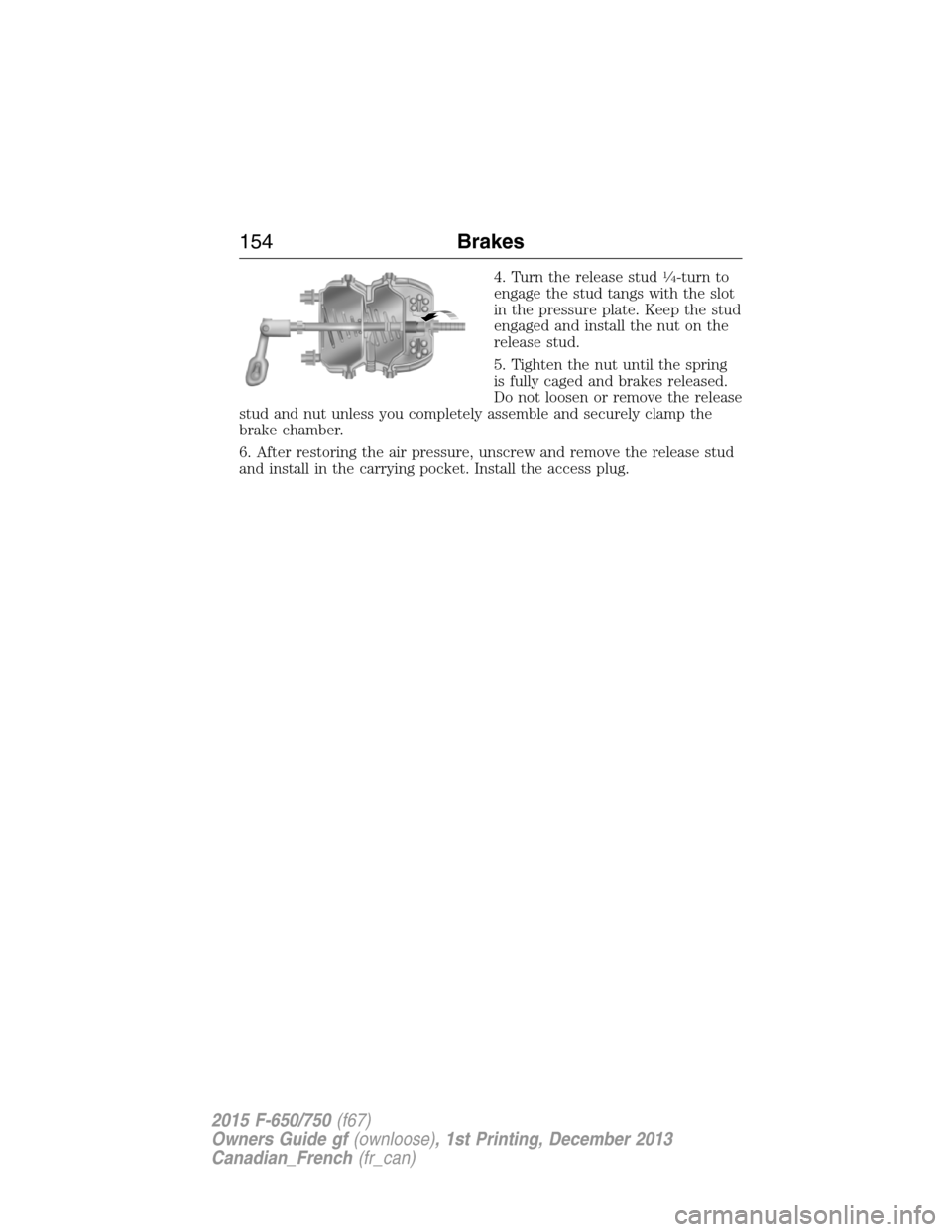
4. Turn the release stud1�4-turn to
engage the stud tangs with the slot
in the pressure plate. Keep the stud
engaged and install the nut on the
release stud.
5. Tighten the nut until the spring
is fully caged and brakes released.
Do not loosen or remove the release
stud and nut unless you completely assemble and securely clamp the
brake chamber.
6. After restoring the air pressure, unscrew and remove the release stud
and install in the carrying pocket. Install the access plug.
154Brakes
2015 F-650/750(f67)
Owners Guide gf(ownloose), 1st Printing, December 2013
Canadian_French(fr_can)
Page 156 of 384
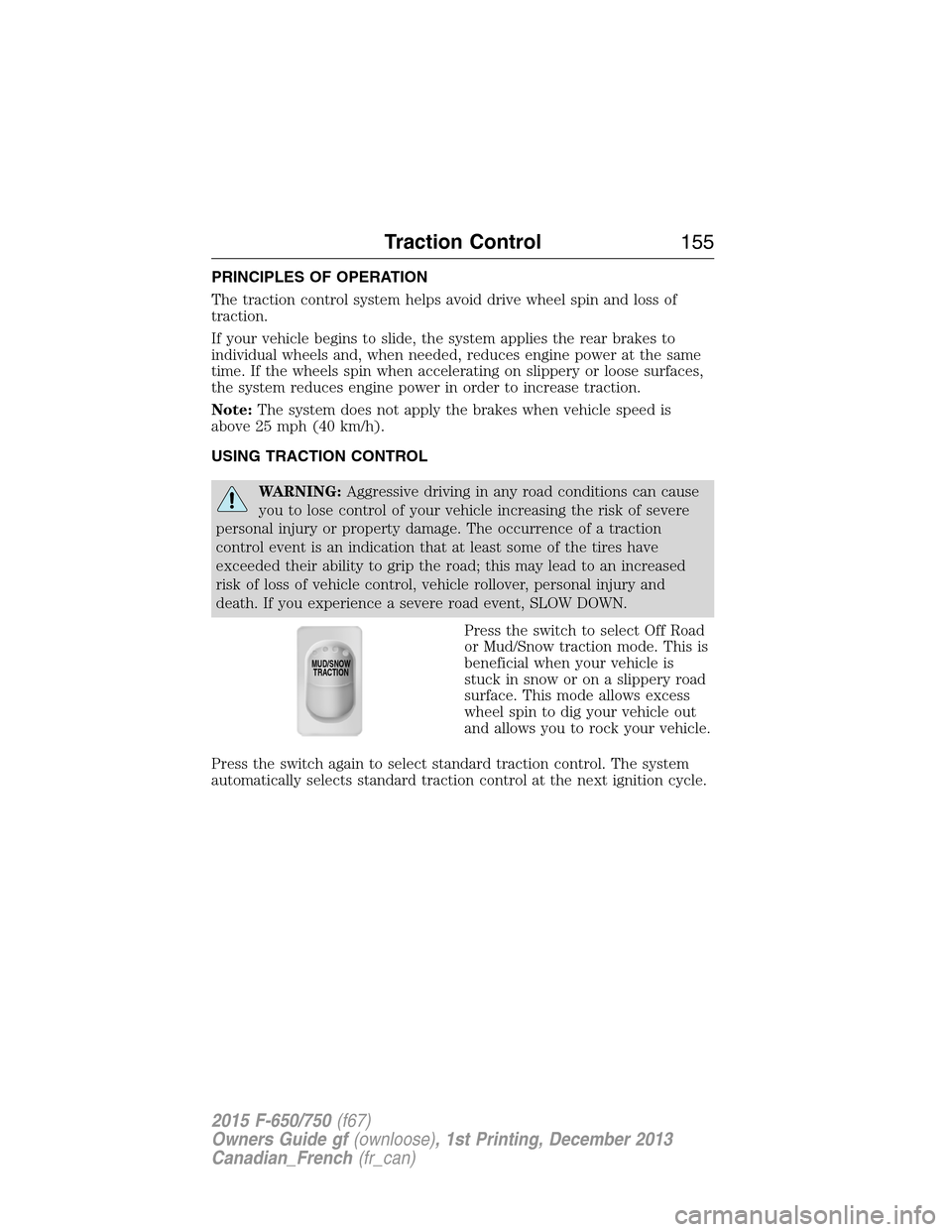
PRINCIPLES OF OPERATION
The traction control system helps avoid drive wheel spin and loss of
traction.
If your vehicle begins to slide, the system applies the rear brakes to
individual wheels and, when needed, reduces engine power at the same
time. If the wheels spin when accelerating on slippery or loose surfaces,
the system reduces engine power in order to increase traction.
Note:The system does not apply the brakes when vehicle speed is
above 25 mph (40 km/h).
USING TRACTION CONTROL
WARNING:Aggressive driving in any road conditions can cause
you to lose control of your vehicle increasing the risk of severe
personal injury or property damage. The occurrence of a traction
control event is an indication that at least some of the tires have
exceeded their ability to grip the road; this may lead to an increased
risk of loss of vehicle control, vehicle rollover, personal injury and
death. If you experience a severe road event, SLOW DOWN.
Press the switch to select Off Road
or Mud/Snow traction mode. This is
beneficial when your vehicle is
stuck in snow or on a slippery road
surface. This mode allows excess
wheel spin to dig your vehicle out
and allows you to rock your vehicle.
Press the switch again to select standard traction control. The system
automatically selects standard traction control at the next ignition cycle.
MUD/SNOW
TRACTION
Traction Control155
2015 F-650/750(f67)
Owners Guide gf(ownloose), 1st Printing, December 2013
Canadian_French(fr_can)
Page 157 of 384
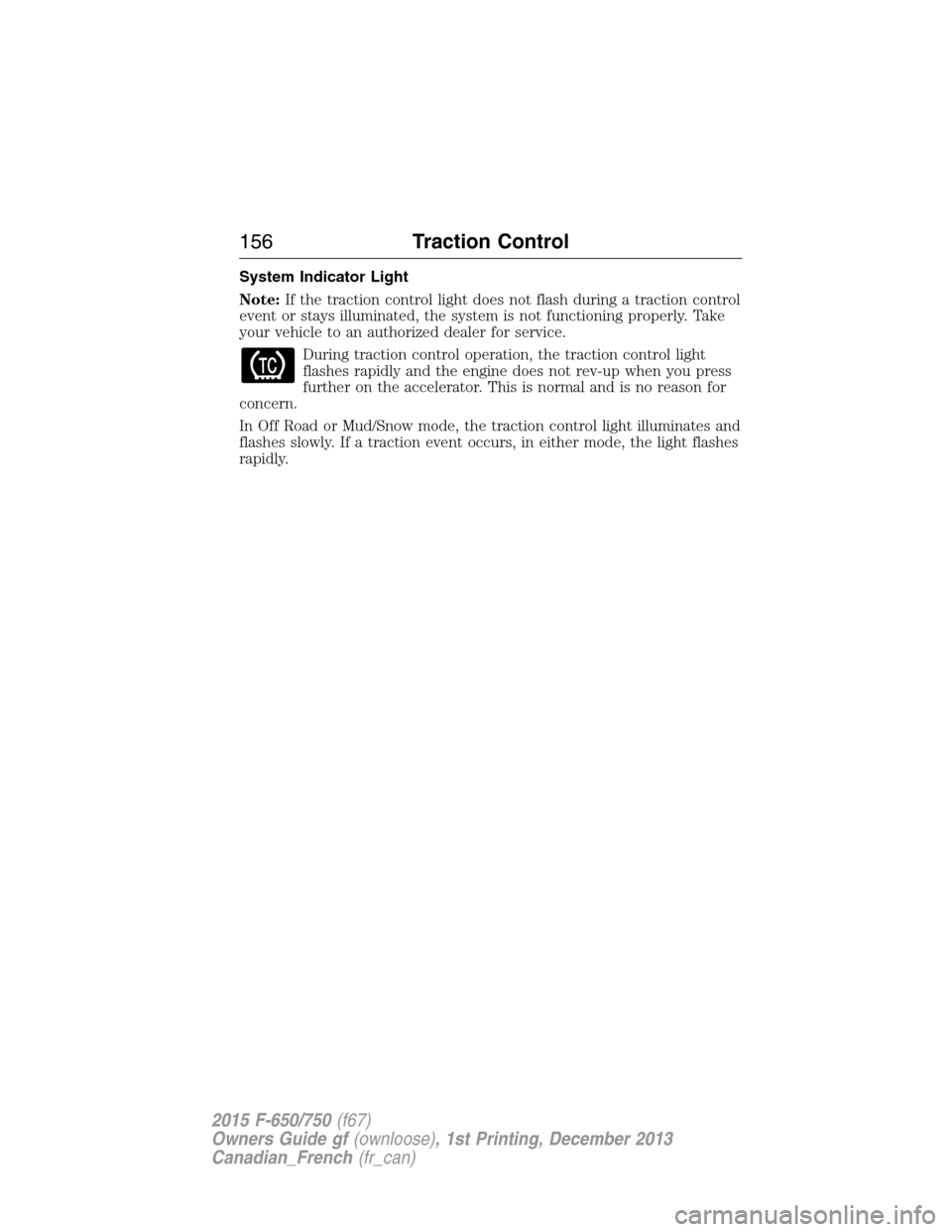
System Indicator Light
Note:If the traction control light does not flash during a traction control
event or stays illuminated, the system is not functioning properly. Take
your vehicle to an authorized dealer for service.
During traction control operation, the traction control light
flashes rapidly and the engine does not rev-up when you press
further on the accelerator. This is normal and is no reason for
concern.
In Off Road or Mud/Snow mode, the traction control light illuminates and
flashes slowly. If a traction event occurs, in either mode, the light flashes
rapidly.
156Traction Control
2015 F-650/750(f67)
Owners Guide gf(ownloose), 1st Printing, December 2013
Canadian_French(fr_can)
Page 158 of 384
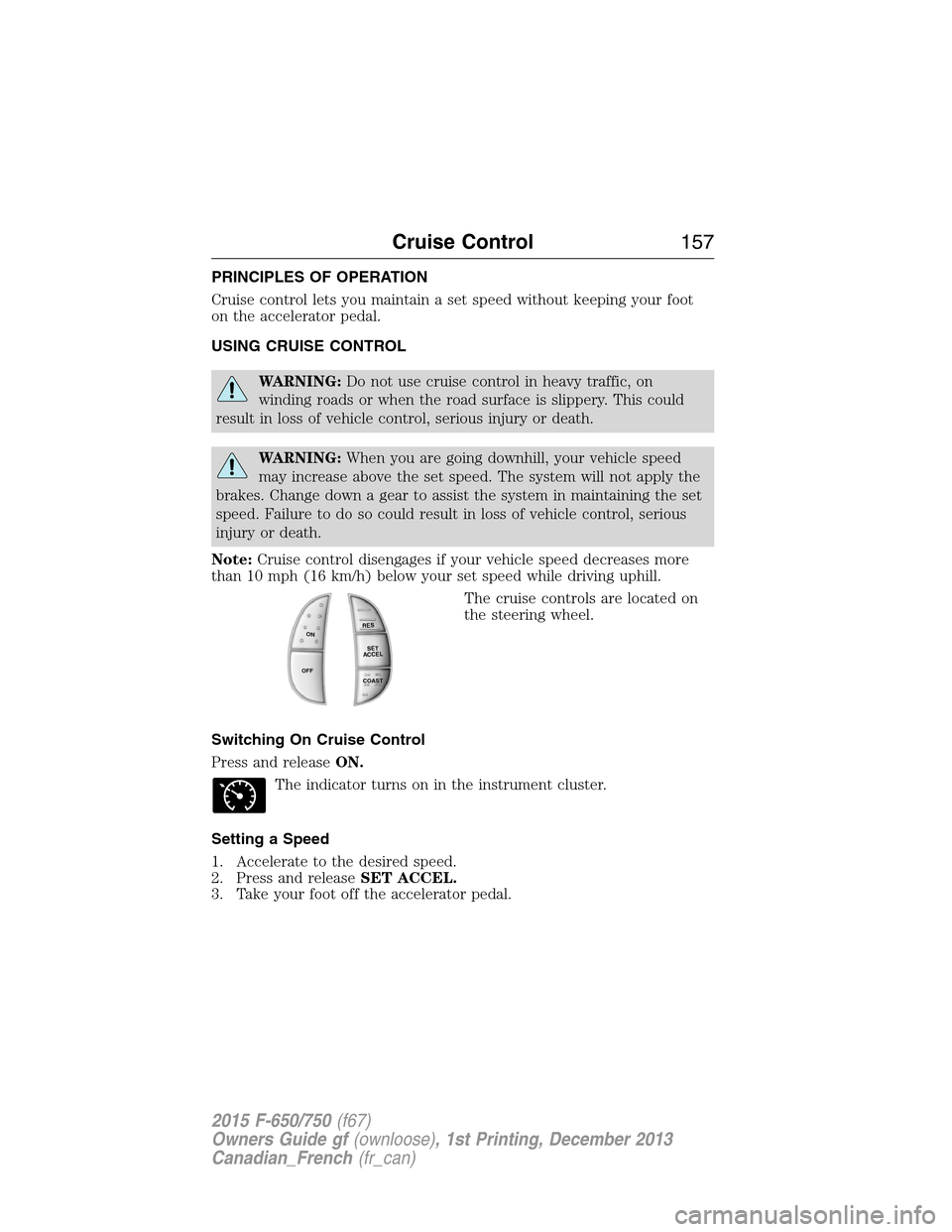
PRINCIPLES OF OPERATION
Cruise control lets you maintain a set speed without keeping your foot
on the accelerator pedal.
USING CRUISE CONTROL
WARNING:Do not use cruise control in heavy traffic, on
winding roads or when the road surface is slippery. This could
result in loss of vehicle control, serious injury or death.
WARNING:When you are going downhill, your vehicle speed
may increase above the set speed. The system will not apply the
brakes. Change down a gear to assist the system in maintaining the set
speed. Failure to do so could result in loss of vehicle control, serious
injury or death.
Note:Cruise control disengages if your vehicle speed decreases more
than 10 mph (16 km/h) below your set speed while driving uphill.
The cruise controls are located on
the steering wheel.
Switching On Cruise Control
Press and releaseON.
The indicator turns on in the instrument cluster.
Setting a Speed
1. Accelerate to the desired speed.
2. Press and releaseSET ACCEL.
3. Take your foot off the accelerator pedal.
R
E
S
S
E
T
A
C
C
E
L
C
OA
S
T
ON
OFF
Cruise Control157
2015 F-650/750(f67)
Owners Guide gf(ownloose), 1st Printing, December 2013
Canadian_French(fr_can)
Page 159 of 384
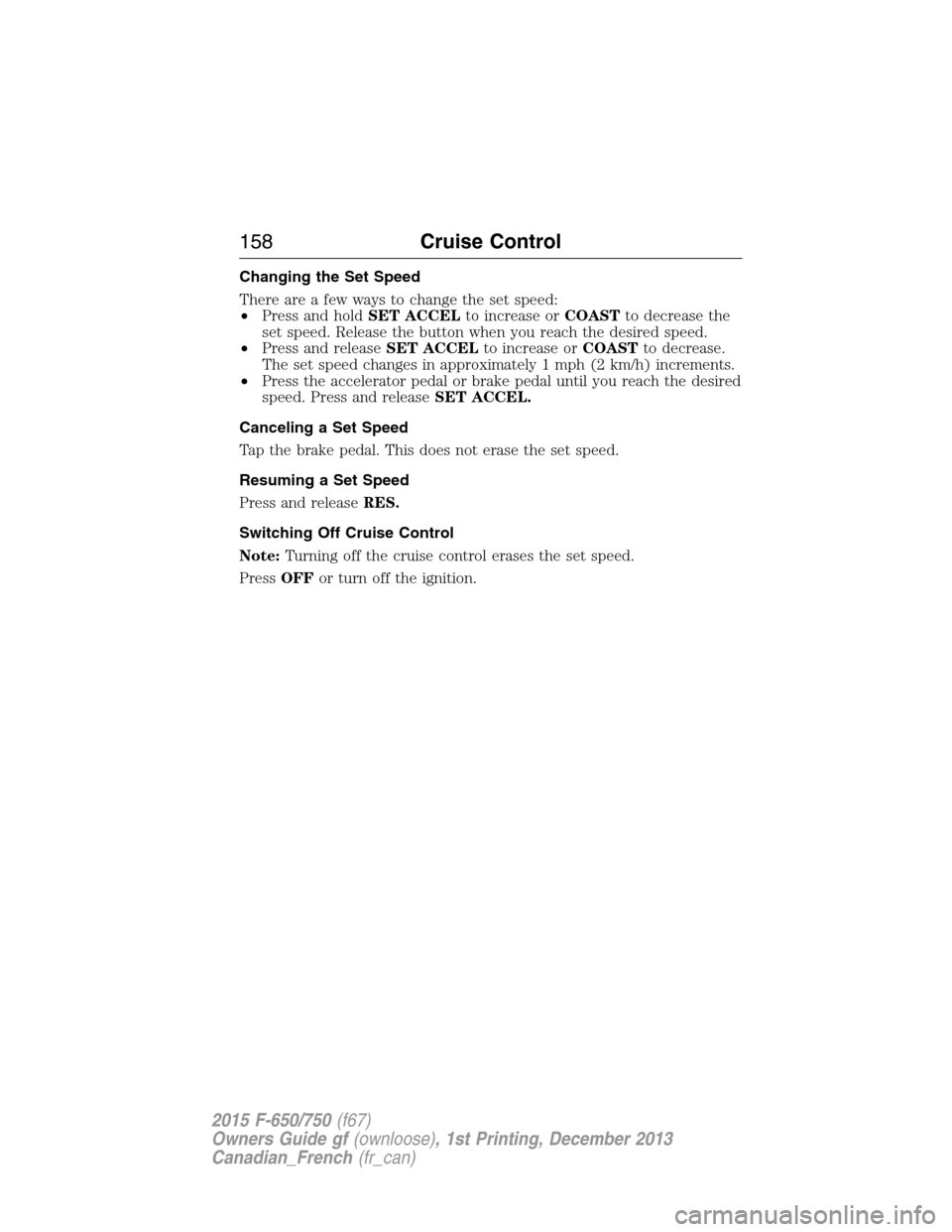
Changing the Set Speed
There are a few ways to change the set speed:
•Press and holdSET ACCELto increase orCOASTto decrease the
set speed. Release the button when you reach the desired speed.
•Press and releaseSET ACCELto increase orCOASTto decrease.
The set speed changes in approximately 1 mph (2 km/h) increments.
•Press the accelerator pedal or brake pedal until you reach the desired
speed. Press and releaseSET ACCEL.
Canceling a Set Speed
Tap the brake pedal. This does not erase the set speed.
Resuming a Set Speed
Press and releaseRES.
Switching Off Cruise Control
Note:Turning off the cruise control erases the set speed.
PressOFFor turn off the ignition.
158Cruise Control
2015 F-650/750(f67)
Owners Guide gf(ownloose), 1st Printing, December 2013
Canadian_French(fr_can)
Page 160 of 384
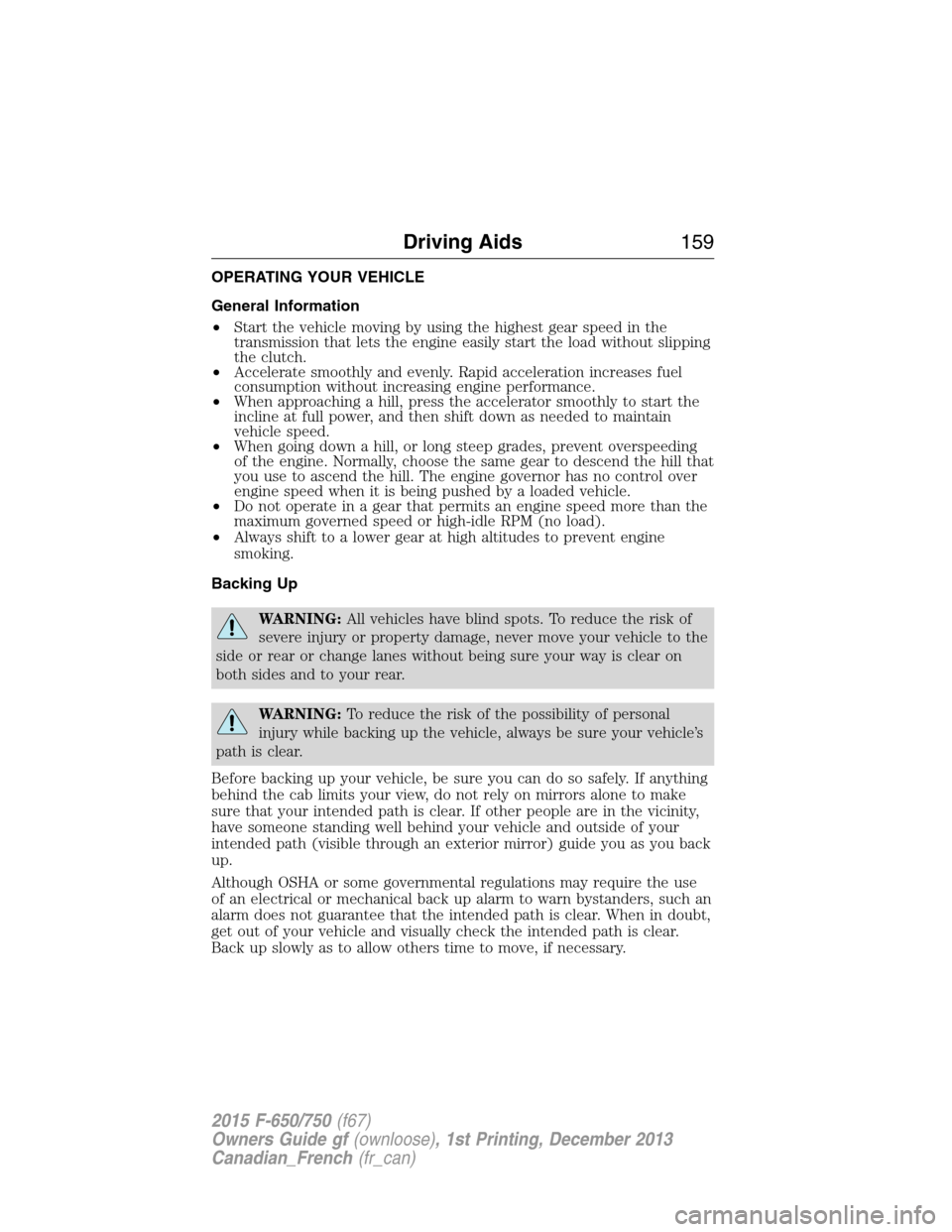
OPERATING YOUR VEHICLE
General Information
•Start the vehicle moving by using the highest gear speed in the
transmission that lets the engine easily start the load without slipping
the clutch.
•Accelerate smoothly and evenly. Rapid acceleration increases fuel
consumption without increasing engine performance.
•When approaching a hill, press the accelerator smoothly to start the
incline at full power, and then shift down as needed to maintain
vehicle speed.
•When going down a hill, or long steep grades, prevent overspeeding
of the engine. Normally, choose the same gear to descend the hill that
you use to ascend the hill. The engine governor has no control over
engine speed when it is being pushed by a loaded vehicle.
•Do not operate in a gear that permits an engine speed more than the
maximum governed speed or high-idle RPM (no load).
•Always shift to a lower gear at high altitudes to prevent engine
smoking.
Backing Up
WARNING:All vehicles have blind spots. To reduce the risk of
severe injury or property damage, never move your vehicle to the
side or rear or change lanes without being sure your way is clear on
both sides and to your rear.
WARNING:To reduce the risk of the possibility of personal
injury while backing up the vehicle, always be sure your vehicle’s
path is clear.
Before backing up your vehicle, be sure you can do so safely. If anything
behind the cab limits your view, do not rely on mirrors alone to make
sure that your intended path is clear. If other people are in the vicinity,
have someone standing well behind your vehicle and outside of your
intended path (visible through an exterior mirror) guide you as you back
up.
Although OSHA or some governmental regulations may require the use
of an electrical or mechanical back up alarm to warn bystanders, such an
alarm does not guarantee that the intended path is clear. When in doubt,
get out of your vehicle and visually check the intended path is clear.
Back up slowly as to allow others time to move, if necessary.
Driving Aids159
2015 F-650/750(f67)
Owners Guide gf(ownloose), 1st Printing, December 2013
Canadian_French(fr_can)